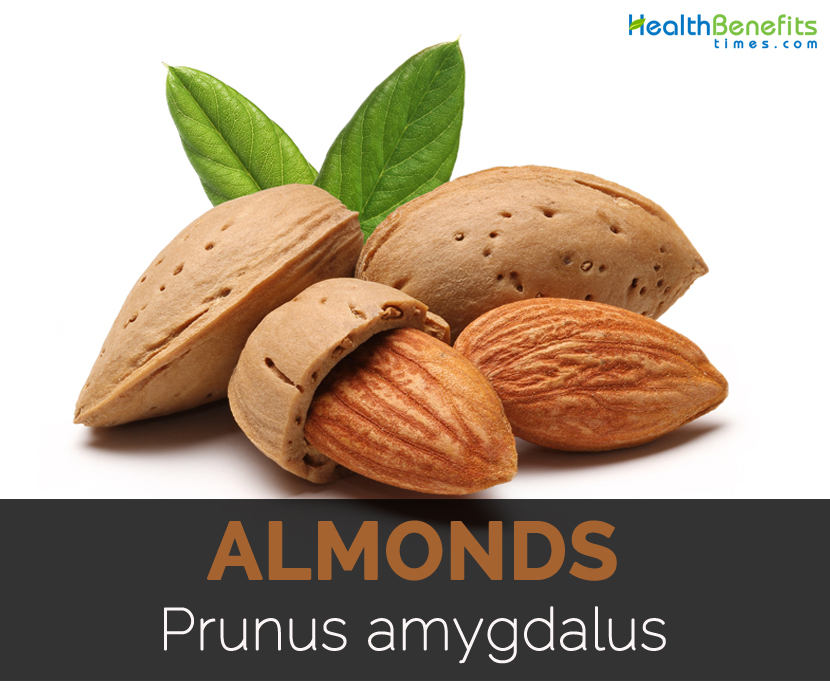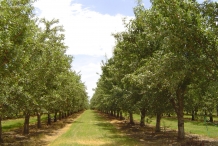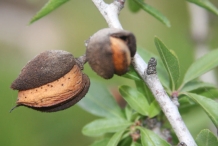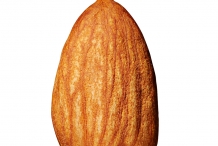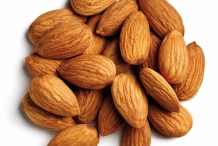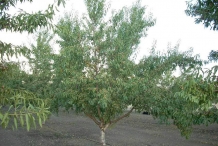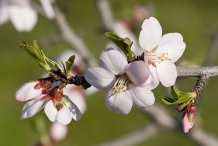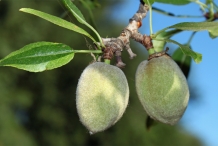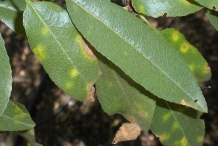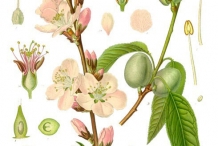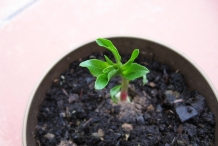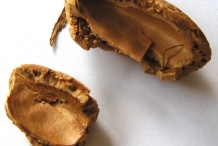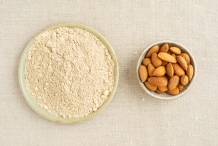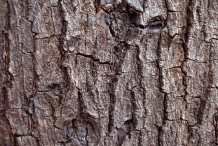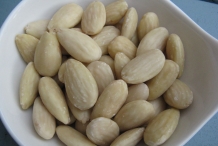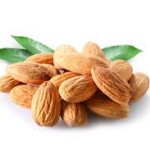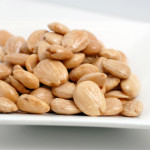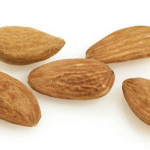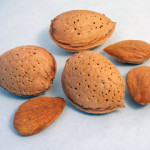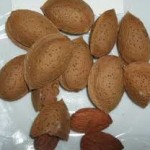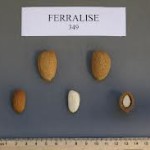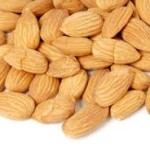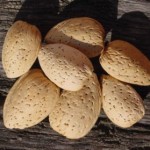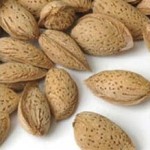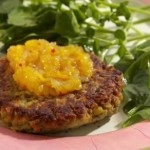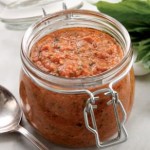The sweet almonds are edible and bitter ones are used to extract oil which is commonly used to enhance favor of the food. It is consumed raw and also use it as an ingredients in casseroles, salads and other dishes. Almond milk is used as an alternative to cow’s milk.
Almond is highly revered in some cultures. It is cultivated in Israel and is mentioned various times in Bible including in Genesis 43:11 where it is represented as “among the best of fruits” and in Numbers 17, where it is named as Aaron’s rod. The blossom also provided as model for menorah that stood in the Holy Temple and Christian symbolism often used branches of almonds as symbol relative to Mary and Jesus. Almond was considered as the symbol of enduring sadness and female beauty by Chinese.
Almond donated values to ecosystem and to human beings. The almond flowers ecologically have beneficial relationship with bees in terms of pollination. For people, almond supplies almond syrup, almond oil and highly nutritious foods which are used in various dishes. Almonds are regarded as a nutritional powerhouse which offers a rich source of riboflavin, protein, copper, vitamin E, calcium, niacin, magnesium, folic acid and potassium.
This particular super nut, either with or without skin, provides a number of vitamins and minerals that the body needs to stay healthy. Almonds are the most nutrient-rich nut among all other nuts. The considerable nutrition found in almonds consist of vitamin B2, vitamin E, potassium, magnesium, iron, manganese, protein, phosphorus, calcium, and copper. In addition, almonds are loaded with dietary fiber as well as monounsaturated fat, that play a role in a healthy heart.
Almonds are normally found in places just like Iran, Saudi Arabia, Lebanon, Turkey, Syria, Jordan and Israel. This particular extremely nutritious nut is really a rich source of vitamin E, calcium, phosphorous, iron as well as magnesium. Additionally, it consists of zinc, selenium, copper and niacin. When compared with all the other nuts, almonds are definitely the most full of nutrients as well as advantageous elements.
Both sweet and bitter almonds can easily be bought. Traditionally, sweet almonds usually are edible, whilst bitter almonds are utilized to make almond oil, a common oil which is used to include taste to food. Almonds are often consumed raw, however, many individuals include them as components in salads, casseroles, along with other dishes. Almond milk is another delightful beverage, as well as an option to less nourishing cow’s milk.You can eat almonds directly, ideally on an empty stomach to improve and speed up the absorption of their nutrients. You are able to soak them in water over night so that you can consume them the morning. Crushed almonds may also be an excellent garnish for several dishes.
Plant
Prunus amygdalus is a small and deciduous tree which measures 3 to 8 meters high with greyish brown bark, unarmed spreading horizontal branches and an open spreading crown. Leaves are medium green, alternate, lanceolate to elliptic lanceolate measuring 3 to 9 cm by 1-2.5 cm. It is sparsely pilose when young that becomes glabrescent with broadly cuneate to rounded base and shallowly densely serrate margin. Flowers are borne laterally on spurs or short lateral branchlets. Flowers are solitary, white to pink and 2 to 5 cm across. Sepals are broadly oblong to broadly lanceolate, apex obtuse and margin. Petals are oblong to obovate-oblong, white or pinkish with base tapering to narrow claw. Fruit is an obliquely oblong to oblong-ovoid drupe measuring 3 to 6 cm by 2 to 4 cm. Endocarp is ovoid, broadly ellipsoid, yellowish white to brown, hard to fragile measuring 2.5 to 4 cm. Trees starts to bear after planting of five to six years. After flowering of 7 to 8 months, fruit matures in autumn.
Drupe
Fruit measures 3.5 to 6 cm long. The exocarp or outer covering is thick, grey to green coat and leathery which is called hull. It has reticulated woody and hard shell which is called endocarp. The seed is inside the shell which is edible and commonly known as nut.
Health Benefits of Almonds
Almonds are used to promote complexion, food movement through colon and also prevents cancer. Almond is used as carrier oil in aromatherapy and also used as a emollient for skin by massage therapists. Almonds are loaded with nutrients such as magnesium, Vitamin E, fiber, manganese, magnesium, copper, fiber, riboflavin and phosphorus. The high content of monounsaturated fats helps to lower LDL cholesterol levels and lowers the chances of heart disease. It is a great source of Vitamin E which acts as an antioxidant that possesses heart protective properties.
- Promote Brain health
Almonds have ample amounts of nutrients that assist in development and health of brain. It is associated with high intellectual level and is considered as an essential food for growing children. Dry fruits contain two vital brain nutrients, L-carnitine and riboflavin which are associated to brain activity that results in new neural pathways and lower occurrence of Alzheimer’s disease. The studies shows that almonds in diet. Soak the almonds in and then give it to the children every morning.
- Maintain cholesterol
The daily intake of almonds promotes high density i.e. HDL cholesterol levels and they lower low density lipoproteins i.e. LDL cholesterol levels. This balance is essential to maintain healthy level of cholesterol and lowers LDL cholesterol.
- Promotes bone health
Almonds are a great source of minerals and vitamins as well as phosphorus. Phosphorus have a great impact on strength and durability of bones and teeth and prevents the onset of age associated conditions such as osteoporosis.
- Prevention of heart ailments
Potassium, protein and mono-unsaturated fats which is contained in almonds that is beneficial for heart health. Vitamin E is an antioxidant which lowers the chances of heart diseases and the presence of magnesium avoid heart attacks. It lowers the chances of heart ailments. It is a great source of folic acid and lowers the level of homocysteine that causes buildup of fatty plaque in arteries. Additionally, almonds skin has flavonoids to form a powerful shield against artery wall damage.
- Strengthen immunity
Almonds have an alkali material which helps to strengthen immune system and also increase ability to counteract diseases and various health problems. Besides high level of alkaline, it has high content of Vitamin E that acts as an antioxidant. It eliminates damaging free radicals in the body. Antioxidants such as Vitamin E affect diseases such as heart disease and cancer.
- Lower inflammation
Certain fatty acids are important and could be helpful for overall health. Body could not create its own fatty acids both linolenic and linoleic acids. These fatty acids help to lower inflammation all around the body. Fatty acids help to lower LDL cholesterol levels and promote healthy hair and skin.
- Blood pressure regulation
Almonds have potassium that helps to regulate blood pressure and low levels of sodium helps to fluctuate blood pressure. The nutrients help to keep the body balanced that could prevent various deficiencies. The balanced minerals and vitamins is essential for healthy lifestyle but when the certain elements are neglected, the whole body is affected that results in stress, anxiety and promotes blood pressure.
- Produces energy
Almonds have copper, manganese and riboflavin which help to produce energy and metabolic rate. When you are on go, keep dry fruits for the day without filling up calories or fat.
- Cancer prevention
Almonds promote food movement through colon by preventing build up and subsequent colon cancer. The research has shown the link between high fiber diets and lower chances of colon cancer.
- Diabetes prevention
Almonds help to lower reactionary rise in glucose and insulin levels after meals. This modulation offers protection from harmful spikes in blood sugar which diabetics suffer from large meal. Almonds assist to regulate absorption and processing of glucose which makes the entire process much smoother and safer.
- Pregnant women
Almonds possess folic acid that helps to lower incidence of birth defects in newborn babies. It stimulates healthy growth of cells and formation of tissues. Neural tube defects are the conditions where the neural tube is either underdeveloped or is partially in fetus. Pregnant women helps to promote proper development of tube and almonds have folic acid that keeps the health of the mothers and their babies.
- Assist to lose weight
Unsweetened almond milk might be helpful for those who are trying to lose weight. Almonds have mono-unsaturated fats that help to satisfy appetite and prevent over eating. It has dietary fiber which contributes the sensation of feeling full. Studies show that almond rich and low calorie diet which is helpful for obese people that helps to shed excess weight. The studies shows that people who intake almonds and suffer fluctuations of weight. Certainly the fiber contributes the consistent bowel movements that supports weight loss and eliminates toxins.
https://www.youtube.com/watch?v=jKEOYX_5_a4
Medicinal Uses of Almond
Almonds form a perfect tonic for the growing child. Soak 3-6 shelled almonds in warm water and than eliminate the skin. Grind them into paste, and blend it along with milk. Add a teaspoon of honey. Feed the child daily. It may also be beneficial in adolescent girls along with delayed puberty; crushed almonds, egg yolk, gingelly (til) powder, along with a teaspoon of honey in milk will make sure good overall development while in adolescence.
- An excellent food supplement in case of general debility as well as convalescence. Soak 12-15 shelled almonds in hot water and take away outer covering. Grind them into fine paste, and blend it with all the buttermilk as well as mash a ripe banana in it. Strain it through a muslin cloth, add 4 teaspoons honey, and drink two times a day. Almond forms a perfect food for diabetics also since it consists of little carbohydrates.
- Almonds increase libido as well as improve general sexual performance in the event of frigidity. Grind a few almonds as well as 2-3 pinches of saffron and eat everyday for 40 days.
- Almonds are a fantastic for constipation. Mash individually 5 teaspoons almonds as well as 5 teaspoons dried dates. Mix them and add 10 teaspoons honey. Take 3 teaspoons of the mixture two times a day.
- In the case of head lice, grind 7-8 kernels along with 1-2 teaspoons lime juice and apply on the scalp. Use a little almond oil around the scalp frequently and massage.
- In the case of tooth ache as well as gum diseases, burn the shells of almonds, powder, and make use of as tooth powder.
- To get rest from psoriasis as well as allied skin troubles, powder a few almonds, boil as well as apply on affected areas and let it remain overnight.
- To improve skin complexion, combine equal amount of almond oil and honey and apply to face. To safeguard from sunburn, use the paste of almonds and milk cream together with coconut oil on exposed skin.
- In the case of insomnia, grind blanched almonds (8-10) together with khuskhus grass powder (1 teaspoon) and milk (half teacup) and smear the paste on palms and soles.
- To get rest from muscle sprains, combine equal portions of almond oil as well as garlic oil and massage over affected areas.
- The burnt ashes of the skins of almond when utilized as tooth powder strengthens the teeth and gum and in addition helps make the teeth white.
- A child who stammers and who can not talk clearly, if almond soaked in water is offered to him right after eliminating its skin and with butter made out of cows milk, it enhances his speech.
- Sweet Almonds provide relief from heart burn.
- Grind the blanched almonds and make its emulsoin with barley water for treating gravel, stone, strangury and disorders of bladder, kidney and biliary ducts.
- In South-East Asia, leaves are used to cure dysentery and the people of Philippines ingest to eliminate intestinal parasites.
- It is used to improve complexion.
- Leaves are used for liver ailments in Taiwan.
- The tea prepared from leaves is used to lower rheumatism.
- In South and Central America, tonic prepared from young leaves are used to cure colic in babies.
- Leaves are also used in traditional folk medicine for treating wounds and skin problems.
- Fruit is used in India to lower leprosy and make dressings for rheumatic pains.
- In Mexico, almond fruit is used to treat asthma and also provide relief from coughs.
- It is used as a folk remedy for constipation, cough, cold, dyspnea, gingivitis, eruption, itch, heartburn, spasms, sores, peptic ulcers and stomatitis.
- Leaves are helpful for treating diabetes.
- It is believed to promote longevity and high intellectual level.
History of Almonds
The almond is indigenous to the Mediterranean climate region of the Middle East, eastward so far as the Indus River in Pakistan.[9] In Iran, India, Afghanistan and Pakistan, it’s called badam. It absolutely was spread by humans in ancient times over the shores of the Mediterranean into northern Africa and southern Europe, and much more recently transported along with other parts of the world, significantly California, United States.
The wild form of domesticated almond grows in parts of the Levant; almonds must first have already been taken into cultivation in this area. The fruit of the wild forms has the glycoside amygdalin, “which becomes transformed into deadly prussic acid (hydrogen cyanide) after crushing, chewing, or other problems for the seed.”
Wild almonds are bitter, the kernel produces deadly cyanide upon mechanical handling, and eating even a few dozen in a single sitting could be deadly. Collection of the sweet type, from the many bitter types in wild, marked the start of almond domestication. How humans chosen the sweet type remains a mystery. It really is unclear as to which wild ancestor of the almond made the domesticated species. Ladizinsky implies the taxon Amygdalus fenzliana (Fritsch) Lipsky is easily the most likely wild ancestor of the almond in part since it is native of Armenia and western Azerbaijan where it absolutely was apparently tamed.
While wild almond species are toxic, domesticated almonds usually are not; Jared Diamond argues that the common hereditary mutation causes a lack of amygdalin, and also this mutant was grown by early farmers, “at first unintentionally within the garbage heaps, and later on intentionally within their orchards”. Zohary and Hopf think that almonds were among the earliest domesticated fruit trees because of “the ability of the grower to boost attractive almonds from seed. Therefore, despite the fact that this plant doesn’t lend itself to propagation from suckers or from cuttings, it might have been domesticated even before the development of grafting”. Domesticated almonds appear in the Early Bronze Age (3000-2000 BC) such as the archaeological sites of Numeria (Jordan), or maybe a little earlier. Another well-known archaeological example of the almond is definitely the fruit present in Tutankhamun’s tomb in Egypt (c. 1325 BC), probably imported from the Levant. Of the European countries that the Royal Botanic Garden Edinburgh reported as cultivating almonds, Germany is the northernmost, although the domesticated form can be obtained as far north as Iceland.
Types of Almonds
Some almond types are listed below-
1. Mollar de Tarragona
Quite big, wide, of more or less dark brown colour, somewhat rough. 40-43% yield on shelling and 5% of double almonds. Average time of flowering, manufactured in Spain.
2. Marcona
Quite a large almond, of round shape, slightly rough. 25-28% yield on shelling; no double almonds. Flowering at the start of March and late maturation at the start of October. It is original from the province of Alicante (Spain).
3. Desmayo Largueta
The tree is of hanging growing habit. There are many local types within the Spanish regions, the most well-known is Desmayo Rojo. Extended, pointed, smooth almond with a hard shell, commercialized under the name of ” Larguetas”. Very precocious flowering and incredibly late maturation. It really is grown in all the Ebro valley, from Zaragoza to Tarragona, and in the bordering provinces of Lérida and Teruel (Spain).
4. Tuono
Hard shell fruit. When ripe, they maintain the peduncles of the fruits around the tree. 30-40% yield on shelling; the proportion of double almonds varies between 15 and 30%. Very late flowering and early maturation. Variety of Puglia (Italy).
5. Ferragnès
Fruits of quite large size, slightly pointed and of brown skin, not very rough. Very late flowering and maturation at the conclusion of September in the region of Nimes (France). It originated in ” Cristomorto’ x “Ai’, in France.
6. Ferraduel
Hard, wide and flattened shell, with thin, dark brown skin. Very late flowering and maturation at the conclusion of September in the region of Nimes (France). It originated in “Cristomorto x “Ai’, in France.
7. Ferralise
Small, thick, clear and incredibly smooth almond. Hard shell, 30% yield on shelling. Very late flowering. Original from the cross ” Ferragnès” x ” Ferraduel”.
8. Bonita
Medium size almond, thick, pale colour, stripped, very attractive. 23% yield on shelling. Late flowering. Portuguese variety.
9. Casa Nova
Great almond, flattened, quite rough. 20% yield on shelling. Later flowering compared to other Portuguese varieties.
10. Parada
Quite large, wide, dark brown almond, somewhat rough yet extremely treasured in Portugal because of its shape. 19-22% yield on shelling. Quite early flowering.
11. Verdal
Quite large an almond, flattened along with a very good taste. 24% yield on shelling. Early flowering. Portuguese variety.
12. Nonpareil
Slightly elongate, thick almonds, with very pale and thin skin. The shell can also be very thin. 60-65% yield on shelling. Very early maturation. It’s the classic Californian variety.
13. Ne plus ultra
Referred to as ” Neplus”. The look of this fruit in the shell is attractive, elongate and clear, however the almond is long and flat, usually with folds and wrinkles. 55-60% yield on shelling. Early flowering and spread out over a long time. Californian variety.
14. Texas
Thick fruit. Late flowering and maturation in the center of October, in Nimes (France). Its origin is California.
Ways to Enjoy Almonds
They are not only a wonderful snack on their own, yet almonds make a great addition to both delicious dishes as well as sweet desserts. One serving of almonds is certainly one ounce, or about 24 nuts. An ounce of almonds consists of about 164 calories, so be cautious about the portion size.
- Mix sliced almonds within your morning cereal or oatmeal.
- Grab a tiny handful of almonds for the hearty on-the-go snack.
- Add slivered almonds to salads as well as stir-fries.
- Add some roasted, slivered almonds in your ice cream sundae for the delicious crunch.
- Add coarsely ground almonds like a “nut crumb” topping to casseroles and pasta dishes.
- Almonds are consumed on its own or are used to garnish various dishes.
- It is a base ingredient in almond milk, almond butter and almond flour.
- Bitter almonds are used for making oil which is used as a flavoring agent for liqueurs and foods.
- Almond syrup is an emulsion of bitter and sweet almonds which is made with barley syrup or in syrup of orange flower water and sugar.
- It is sprinkle over desserts.
- Almonds are also processed into milks.
- In China, almonds are mixed with milk and served hot.
- In India, almonds are used as a base ingredient for making pasanda style curries.
- In Europe, marzipan a sweet paste which is used in candy and pastries is made from almonds.
- In Asia, almonds are used in fish, poultry, meat and vegetarian dishes.
- It is consumed raw, baked, fried, salted and after soaking in the water overnight.
- It is also used for preparing cakes, desserts, sweets and cookies.
- Almonds are grounded in the form of powder for using it in confectionery and bakery.
- Add some roasted, slivered almonds in your ice cream sundae for the delicious crunch.
- Add coarsely ground almonds like a “nut crumb” topping to casseroles and pasta dishes.
- Roast almonds for a crunchy taste.
- Make a delicious smoothie by blending fruits, almond milk and frozen yogurt.
- Use blanched almonds to garnish on sweets and cakes.
- The paste made from almonds is used to prepare vinaigrettes or soups.
- Sprinkle almonds over sweet dish.
- Use the diced almonds for stuffing and coatings.
- An almond flour is used for making pastries, cakes, candies and breads.
- Almonds are used in desserts such as nougat, baklava, marzipan and macaroons.
- In Spain, almonds are lightly fried in oil and used for making dessert named turrón.
- In the Middle East, fruit is dipped in salt in order to balance the sour taste. Also, it is consumed with dates.
- Mix chopped almonds and dried fruit to the plain yogurt to add some punch.
- Add sliced almonds to a sauté of curried vegetables. p
- Add almond butter to breakfast shake.
- Prepare a cold rice salad with fresh garden peas, almonds and currants.
- Sliced almonds could be added to chicken salad.
- Add the almonds to soup, salad and pasta.
Precautions
- Avoid too much consumption because bitter almonds contain cyanide.
- Consume it in moderate amounts because excessive consumption causes bloating, abdominal pain, Vitamin E overdose, digestive system problems and headache.
- People with known allergy must avoid it.
- It might cause allergic symptoms such as tingling or numbness of lips or mouth.
- Consume it as per your digestive strength.
- Almonds have high content of oxalate so people with kidney stones should consult the doctor for consumption.
Recipe of Almonds
1. Aromatic chicken with almonds
Ingredients
- 6-8 chicken thighs depending on size, skin removed
- ½ lemon, juiced
- 2 tsp salt
- 4 onions, peeled and finely sliced
- 3 tbsp flavourless oil
- 4 large garlic cloves, peeled and crushed
- 4cm ginger, peeled and grated
- 1 tsp ground cumin
- 1 tsp ground coriander
- ½ tsp turmeric
- ½-1 tsp cayenne pepper, to taste
- 1 stick cinnamon
- 4 black or 8 green cardamom pods
- 4 cloves
- 250g tomato passata
- 120g ground almonds
- A small bunch coriander, roughly chopped
- 80g flaked almonds, toasted
Directions
- 1 Prick the chicken thighs all over using a fork, and rub together with the lemon juice as well as salt. Allow sit for at least half an hour or so – if it is possible overnight.
- 2 Fry the onions in 1 tbsp of oil in the heavy-based pan using a pinch of salt on the medium heat, till they’re light brown (about 15 minutes), stirring regularly.
- 3 Add some garlic and ginger. Cook for around 3-4 minutes, stirring constantly. Then add the ground spices and toast for a few minutes. Add the whole spices and brown for 2 minutes, then add the tomato passata, ground almonds and 250ml hot water. Provide for the boil.
- 4 In the big fry pan rapidly fry the chicken in oil till it features a little colour. Add to the sauce. Simmer very gently for around an hour until the chicken is very tender; preferably in a low oven. Stir occasionally to stop it sticking, adding a little hot water if necessary.
- 5 Once the chicken is soft, leave to sit for the good half hour just before serving. Scatter together with the chopped coriander as well as toasted flaked almonds to serve.
2. Flourless Honey-Almond Cake
Ingredients
Cake
- 1 1/2 cups whole almonds, toasted (see Tip)
- 4 large eggs, at room temperature (see Tip), separated
- 1/2 cup honey
- 1 teaspoon vanilla extract
- 1/2 teaspoon baking soda
- 1/2 teaspoon salt
Toppings
- 2 tablespoons honey
- 1/4 cup sliced almonds, toasted (see Tip)
Directions
- Preheat oven to 350°F. Coat a 9-inch springform pan along with cooking spray. Line the bottom along with parchment paper and spray the paper.
- Process whole almonds in the food processor or even mixer till finely ground (you’ll have about 13/4 cups ground). Beat 4 egg yolks, 1/2 cup honey, vanilla, baking soda as well as salt in the huge mixing bowl with the electric mixer (or utilize a paddle attachment on the stand mixer) on medium speed till well combined. Add the ground almonds and beat on low until combined.
- Beat 4 egg whites in another huge bowl together with the electric mixer (utilize clean beaters on the hand-held mixer or even the whisk attachment on a stand mixer) on medium speed till very foamy, white as well as doubled in volume, although not stiff enough to hold peaks, 1 to 2 minutes (depending on the kind of mixer). Utilizing a rubber spatula, gently fold the egg whites to the nut mix till just combined. Scrape the batter to the prepared pan.
- Bake the cake till golden brown along with a skewer inserted in the center comes out clean, about 28 minutes. Let cool in the pan for 10 minutes. Run a knife round the edge of the pan and gently eliminate the side ring. Let cool completely.
- If desired, eliminate the cake from the pan bottom by gently sliding a sizable, wide spatula between the cake and the parchment paper. Carefully transfer the cake into a serving platter. To serve, drizzle the top of the cake with honey and sprinkle with sliced almonds.
3. Almond-Crusted Pork with Honey-Mustard Dipping Sauce
Ingredients
- 1 cup coarse dry breadcrumbs, preferably whole-wheat (see Note)
- 1/2 cup sliced almonds
- 1 teaspoon garlic powder
- 1/2 teaspoon kosher salt
- 1/4 teaspoon freshly ground pepper
- 1 large egg white, beaten
- 1 pound pork tenderloin, trimmed and cut diagonally into 1/2-inch-thick slices
Dipping Sauce
- 1/4 cup honey
- 2 tablespoons reduced-sodium soy sauce
- 2 tablespoons Dijon mustard
Directions
- Preheat oven to 425°F. Set a wire rack on the baking sheet and coat it with cooking spray.
- Place breadcrumbs, almonds, garlic powder, salt and pepper in the mixer; pulse prior to the almonds are coarsely chopped. Transfer the mixture into a shallow dish.
- Place egg white in another shallow dish. Dip both sides of every pork slice in egg white, then evenly coat together with the almond mixture. (Discard any remaining egg white and almond mixture.) Put the pork on the prepared rack and coat on both sides along with cooking spray.
- Bake the pork till golden brown with no longer pink within the center, 16 to 18 minutes.
- Meanwhile, whisk honey, soy sauce and mustard in a tiny bowl. Serve the pork together with the honey-mustard sauce.
4. Lentil & Almond Burgers
Ingredients
- 6 cups water
- 1 cup brown or French green lentils
- 2 tablespoons extra-virgin olive oil, divided
- 3/4 cup finely chopped carrot
- 1/3 cup finely chopped shallots (about 2 medium)
- 1/3 cup finely chopped celery (about 1 stalk)
- 1/4 cup sliced almonds
- 1 teaspoon chopped fresh thyme
- 1/2 teaspoon salt
- 1/4 teaspoon freshly ground pepper
- 1 large egg yolk, lightly beaten
- 1 tablespoon lemon juice
Directions
- Bring water into a boil in the big saucepan. Mix in lentils, reduce heat to medium-low and simmer till very soft and starting to break down, about 25 minutes for brown lentils or 30 minutes for green lentils. Drain in the fine-mesh sieve.
- Meanwhile, heat 1 tablespoon oil in the big skillet over medium heat. Add carrot, shallots and celery and cook, stirring, till softened, about 3 minutes. Add almonds, thyme, salt and pepper; continue cooking till the almonds are gently browned, about 2 minutes.
- Transfer the mix into a food processor; add 1 cup of the cooked lentils. Pulse several times, scraping down the sides a couple of times, till the mixture is coarsely ground. Transfer to the big bowl; stir within the remaining lentils. Let cool for 10 minutes. Blend egg yolk as well as lemon juice. Cover and refrigerate for 1 hour.
- Form the lentil mixture into 5 patties. Heat the remaining 1 tablespoon oil in the big non-stick skillet, preferably cast-iron, over medium-high heat. Add some patties and cook for 3 to 4 minutes. Turn gently and continue to cook till lightly browned and heated through, 3 to 4 minutes more. Serve instantly.
5. Cherry-Almond Farro Salad
Ingredients
- 1 cup farro, rinsed
- 2 cups water
- 1/2 teaspoon salt, divided
- 1/4 cup white balsamic vinegar
- 3 tablespoons extra-virgin olive oil
- 1/4 teaspoon freshly ground pepper
- 2 cups sweet cherries, pitted and halved
- 1/2 cup diced ricotta salata or feta cheese
- 1/4 cup slivered almonds, toasted
- 3 tablespoons finely diced red onion
- 2 tablespoons chopped fresh mint
Directions
- Combine farro, water as well as 1/4 teaspoon salt in the medium saucepan. Bring to a boil over high heat. Decrease heat to maintain a light simmer, cover and cook till the farro is tender, 20 to 30 minutes. Drain any remaining liquid and fluff using a fork. Spread the farro out on a big rimmed baking sheet to cool for 10 minutes.
- Meanwhile, whisk vinegar, oil, pepper and also the remaining 1/4 teaspoon salt in the large bowl. Add cherries, ricotta salata (or feta), almonds, onion, mint and also the farro. Gently stir to mix.
6. Roasted Tomato & Almond Pesto
Ingredients
- 3/4 cup blanched sliced or slivered almonds
- 1 28-ounce can plus one 14-ounce can diced fire-roasted tomatoes, drained
- 3/4 cup lightly packed fresh basil leaves
- 1 tablespoon plus 1 teaspoon red-wine vinegar
- 1/4 teaspoon crushed red pepper, or to taste
- 3/4 cup extra-virgin olive oil
- 3/4 cup freshly grated Parmesan cheese
- 1/2 teaspoon salt
Directions
- Toast almonds within a huge dry skillet over medium-high heat, mixing frequently, till golden and fragrant, 3 to 5 minutes. Permit them to cool slightly.
- Transfer the almonds into a food processor as well as process till finely ground. Add tomatoes, basil, vinegar and crushed red pepper. Since the processor is running, drizzle in oil in the steady stream, about 30 seconds. Stir in Parmesan and salt. Fresh Tomato Variation: You may also make this pesto with fresh, in-season tomatoes. Begin with 3 pounds fresh plum tomatoes, cut into quarters and divide them in between 2 large baking sheets. Roast at 400° for 30 minutes. Make use of the roasted tomatoes in place of the diced tomatoes in Step 2.
Dose of Almonds
- For average people- A standard serving of almonds is one ounce in accordance with the Food and Drug Administration. Weighing your almonds rather than counting them will help you be certain that you’re getting an exact serving size when you eat them. Almonds may differ in size, which makes it difficult to acquire an exact measurement in case you are trying to view your intake.
- For dieters- In case you are watching your total fat and calorie intake you may use almonds to lose weight and stop heart disease. However, you have to keep in mind that almonds are loaded with fat so you may have to limit your intake in case you are attempting to lose weight. Consuming 1.5 ounces of almonds during the day may help you lose weight since the almonds are loaded with fiber which takes your body a long time to digest. This will assist keep you full so that you are not lured to consume more.
- For patients- People with gallbladder issues or perhaps a kidney stone might need to prevent almonds because of their higher oxalate content. Many are allergic to almond protein and may have an hypersensitive reaction if they consume these nuts. Although this allergic reaction is rare, it is very important to note. It’s also wise to not consume bitter almonds raw simply because they consist of prussic acid and hydrocyanic acid which are toxic.
References:
https://www.itis.gov/servlet/SingleRpt/SingleRpt?search_topic=TSN&search_value=24775#null
https://en.wikipedia.org/wiki/Almond
https://www.britannica.com/plant/almond
http://www.indianalmondleaves.com/folkmedicine.php
http://www.askdrmao.com/natural-health-dictionary/almond/
https://caloriebee.com/nutrition/Almonds-And-Health
https://www.bimbima.com/ayurveda/badam-health-benefits/1425/
https://www.tarladalal.com/glossary-almonds-378i
http://www.stylecraze.com/articles/amazing-health-benefits-of-almonds/#gref
https://www.organicfacts.net/health-benefits/seed-and-nut/health-benefits-of-almonds.html
Comments
| Almonds Quick Facts | |
|---|---|
| Name: | Almonds |
| Scientific Name: | Prunus amygdalus |
| Origin | Indigenous to the Mediterranean climate region of the Middle East (Syria, Lebanon, Israel and Jordan and Turkey eastward to Pakistan). |
| Shapes | Obliquely oblong to oblong-ovoid drupe, 3 to 6 cm by 2 to 4 cm |
| Taste | Sweet, buttery |
| Calories | 828 Kcal./cup |
| Major nutrients | Vitamin E (244.33%) Total Fat (204.00%) Copper (163.78%) Manganese (135.48%) Vitamin B2 (125.15%) |
| Health benefits | Promote Brain health, Maintain cholesterol, Promotes bone health, Prevention of heart ailments, Strengthen immunity |
| Name | Almonds |
|---|---|
| Scientific Name | Prunus amygdalus |
| Native | Indigenous to the Mediterranean climate region of the Middle East (Syria, Lebanon, Israel and Jordan and Turkey eastward to Pakistan). |
| Common/English Name | Almond, Sweet Almond, Bitter Almond, Flowering almond |
| Name in Other Languages | Afrikaans: Amandel; Albanian: Bajame, Bajamja; Amharic: Lawz, ‘a-le-mo-ne-de, Almond, ālimonidi (አልሞንድ); Arabic: Lawzah (لوزة), Lawz, Luz (لوز), ; Aramaic: Badam, Qataraq, Luz, Shegd, Shegda; Armenian: Noosh, Nush (Նուշ), Nuš; Azerbaijan: Badam; Basque: Alemndra, Amanda; Belarusian: Mihdaly, Mindai; Brazil: Amêndoa-Doce, Amêndoa-Amarga, Amendoeira; Breton: Alamandez, Alamandez Dous; Bulgarian: Badem, Бадем; Catalan: Ametler; Chinese:- Cantonese: Hahng Yahn, Bian Tao, Mandarin: Ba Tan Hsung, Ben Tao, Xing Ren; Coptic: Karia; Croatian: Badem, Mendula; Czech: Mandloň Obecná Hořká, Mandloň Obecná; Danish: Bittermandel, Mandel; Dutch: Amandelboom, Amandel; Esperanto: Migdalo; Eastonian: Harilik Mandlipuu; Farsi: Badam; Finnish: Manteli, Tarhamanteli; French: Amandier Amer, Amande, Amandier, Prunier domestique, Amandier Commun; Frisian: Mangel; Gaelic: Cno Ghreugach, Almon; Garo: Badam Pol; Georgian: Nushi (ნუში), nuši; German: Bittermandelbaum, Mandel, Knackmandel, Mandelbaum, Süsser Mandelbaum; Greek: Amygdalia, Amigdalia; Hebrew: Shaqed, Almond, Shaked; Hungarian: Mandula, Keserű Mandula; Iceland: Mandla; India:– Assamese: Badam, Bengali: Badam, Katbadam; Garo: Bada Pol, Gujarati: Badam, Hindi: Badam, Kannada: Badamu, Baadaami, Badaami, badāmu (ಬದಾಮು), bādāmi (ಬಾದಾಮಿ), Malayalam: Badam, Badamkotta, Badam Kayu, Marathi: Baadaam, Badam, badām, Badāma (बदाम); Punjabi: Badam, Sanskrit: Alabukhara, Vatamah, Vatadah, Badama, Tamil: Padam, Vatamkottai, Paruppu (பருப்பு), Vaadumai, Vatumai, Vātumai (வாதுமை); Telugu: Badamvittulu, Baadaamu, Baadaamamu, Badamupappu, Paarsibaadami, Urdu: Badam; Italian: Mandorlo; Japanese: Amendo, Amond, āmondo (アーモンド) ; Kazakhstan: Badamgül, Badam, Ïtbadam; Khais: Budam; Korean: Amondu, a-mon-deu, Amondu, amondeu (아몬드); Latvian: Mandele; Lithuanian: Migdolai: Macedonia: Badem; Malay: Badam; Maltese: Lewż; Mongolian: Büjls; Norwegian: Mandel; Persian: Baadaam; Polish: Migdałowiec Pospolity, Migdal, Migdał Zwyczajny; Portuguese: Amêndoa, Amendoeira-Amarga, Amendoeira, Amendoeira-Doce; Romanian: Migdală, Migdal; Russian: Mindal’ Obyknovennyj (миндаль обыкновенный), Mindal, Mindal’ (Миндаль); Serbian: Badem; Slovašcina: Mandljevec; Slovencina: Mandľa Obyčajná; Scottish Gaelic: Cno ghreugach; Spanish: Almendro, Almendra, Migdalujo; Swahili: Lozi; Swedish: Mandel, Bittermandel; Tajikstan: Bodom; Thai: Alomon, Aelmon; Turkish: Baadaam, Badem; Ukrainian: Mygdal, Miġdal’, Миґдаль; Uzbekistan: Bodom; Vietnamese: Hạnh; Welsh: Almon; Yiddish: Mandl; Nepalese: badaama; Urdu: badam Icelandic: Mandla |
| Plant Growth Habit | Small and deciduous tree |
| Growing Climate | Mediterranean |
| Bark | Greyish brown |
| Leaves | Lanceolate to elliptic lanceolate, 3 to 9 cm by 1 to 2.5 cm |
| Flowering Season | March to April |
| Flower | Solitary, white to pink, 2 to 5 cm across, 3 to 5 cm diameter |
| Fruit shape & size | Obliquely oblong to oblong-ovoid drupe, 3 to 6 cm by 2 to 4 cm |
| Shell | Hard |
| Seed | Flattened, long-ovoid, brown-coated |
| Seed skin | Thin, brownish |
| Flavor | Mild |
| Taste | Sweet, buttery |
| Fruit Season | July to August |
| Major Nutritions | Vitamin E (alpha-tocopherol) 36.65 mg (244.33%) Total Fat (lipid) 71.4 g (204.00%) Copper, Cu 1.474 mg (163.78%) Manganese, Mn 3.116 mg (135.48%) Vitamin B2 (Riboflavin) 1.627 mg (125.15%) Phosphorus, P 688 mg (98.29%) Magnesium, Mg 386 mg (91.90%) Tryptophan 0.302 g (68.64%) Iron, Fe 5.31 mg (66.38%) Isoleucine 1.074 g (64.23%) |
| Calories in 1 cup whole (143 gm) | 828 Kcal. |


